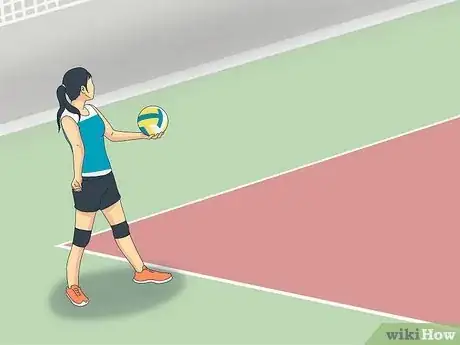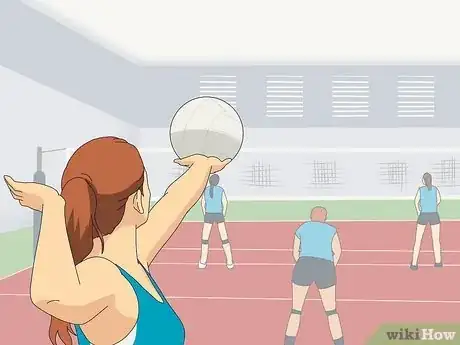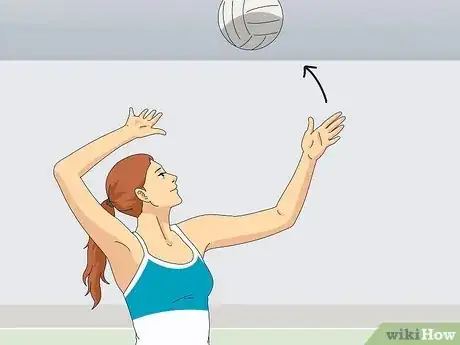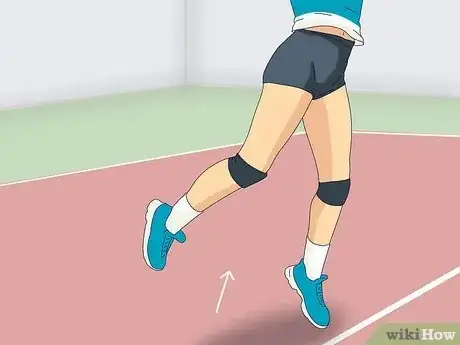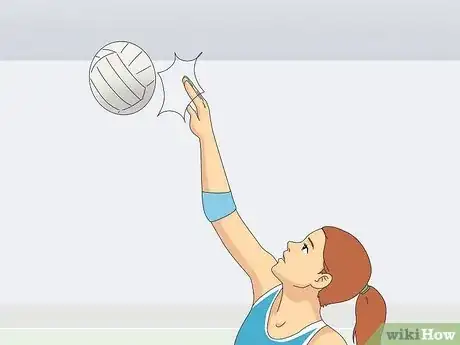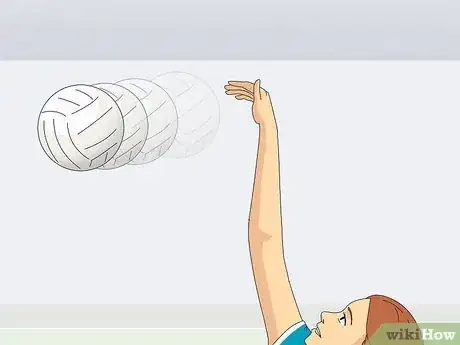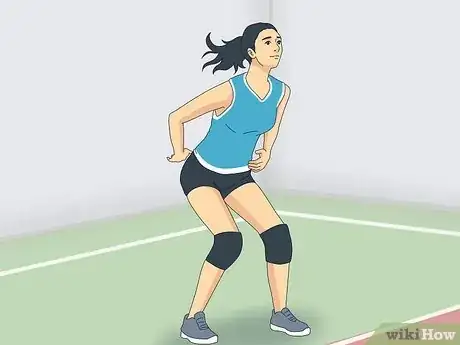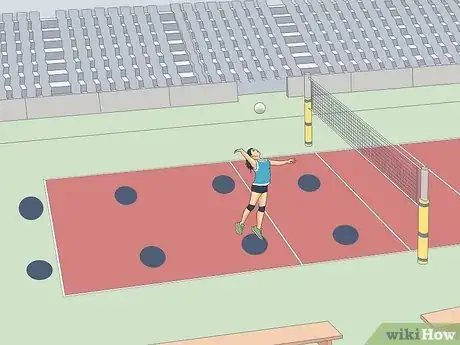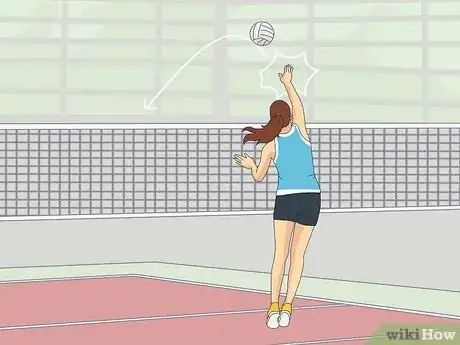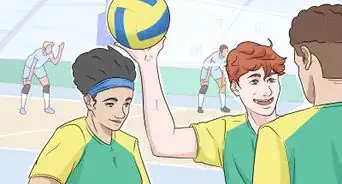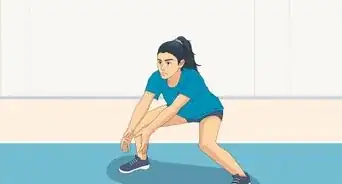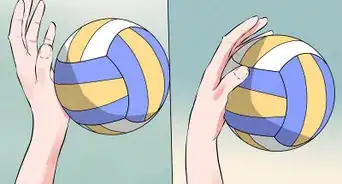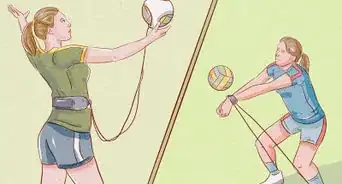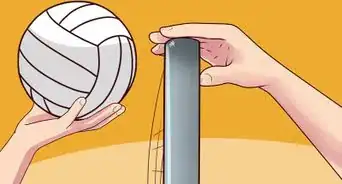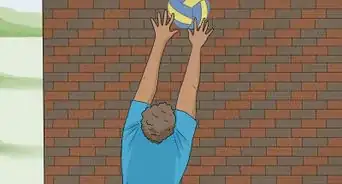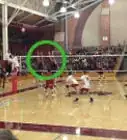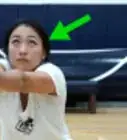This article was co-authored by wikiHow Staff. Our trained team of editors and researchers validate articles for accuracy and comprehensiveness. wikiHow's Content Management Team carefully monitors the work from our editorial staff to ensure that each article is backed by trusted research and meets our high quality standards.
wikiHow marks an article as reader-approved once it receives enough positive feedback. In this case, 100% of readers who voted found the article helpful, earning it our reader-approved status.
This article has been viewed 202,727 times.
Learn more...
A jump serve is an advanced volleyball serve where the ball is thrown into the air and the player makes contact with it by jumping and hitting it in midair. This is a popular serve in college and professional volleyball games because it has a lot of power and speed. Mastering the jump serve can confuse and demoralize the opposing team, which is a good way to rack up points quickly.
Steps
Throwing the Ball
-
1Position yourself. Stand two-three feet behind the back line. You will want to throw the ball high and step to the line in order to gain momentum for your jump.
- Start with your left foot forward if you are right handed, and your right foot forward if you are left handed. You will take a three step approach.
-
2Aim your serve. Look to the positions of the players on the opposing team and try to aim your serve in the empty spaces. You want to hit the ball into “dead zones”. This means that when you hit the ball, you want it to land between players, so that they have to communicate about who will hit the ball back.
- Position your body so that you are facing one of the dead zones. Turn your hips and shoulders toward the area. You should not have to turn your head to look at it.
Advertisement -
3Toss the ball in the air. To do a float serve, use both hands. To make the ball spin, throw it up with your dominant hand with a topspin. Toss the ball high and in front of you. You should be able to do an approach before you hit the ball, so make sure that you throw it in front of you and high enough, so that it floats just behind the serving line.
- A good rule is to throw the ball the way that you like the ball to be set to you. If you like your sets low, then throw the ball lower. If you like your sets higher, throw the ball higher.
Hitting the Ball
-
1Jump to hit the ball in mid-air. Do your regular hitting approach: Slow left step, and then two fast steps: right, left. Do the opposite if you are left handed. Jump with both feet, and hit the ball hard with your dominant hand.[1]
- Aim your jump so that you remain in the serving area. If you hit the ball when you are outside the service area, the serve will be void.
-
2Hit the ball midair. Contact it with as much surface area of your hand as possible, and flick your wrist for a topspin. Hit more with the palm of your hand for a float serve. Hit it as hard as possible. This is where the force and momentum of the jump serve comes from.
- Contact the ball with a fully extended arm and jump high. If you do, the ball should clear the net and land deep.
-
3Aim the ball and follow through. When hitting the ball, your eyes should be on the ball. After you've hit it, bring your hitting arm down. Point your hand toward the place that you want the ball to land.
- Follow through with your eyes as well. This will ensure that you focus on the ball from the moment of contact until your follow through.
-
4Land your jump. As long as you were behind the service line when you hit the ball, your serve should be legal. However, to be safe, you should try to land behind the service line as well. If you overshoot your landing, you may accidentally hit the ball too close to the court.
- Land with both feet. Keep your knees bent to avoid any injuries.
Drilling for the Jump Serve
-
1Prepare eight balls for the drill.[2] Place a pair of balls at four intervals along the court. The first pair should be at the net. The next pair should be three steps back, and the next pair three steps back from that. The final pair should be at the serving line.
- Placing balls close to the net gives you a good idea of the height you need to extended your jump and your arm in order to get the ball over the net.
-
2Hit one ball from each pair over the net. Do not jump to hit the ball. Instead, toss the ball high in the air and swing your arm up to hit it. You should hit the ball when your arm is fully extended. Start with the ball closest to the net and move backwards until you are hitting the ball from the serving line.
- It is important that you do not jump, so that you get a sense of how long your body and arm should be extended. You want to use the same position when you jump serve, with your arm fully extended.
-
3Hit the second ball from each pair over the net. This time, jump when you hit the ball. The first hit, close to the net, should give you an idea of how high you should jump. Each time you hit a ball further away, you should be hitting it a little bit harder.
- As you get back to the serving line, use everything that you have learned thus far. You should be jumping and fully extending your arm just as you did before you were jumping. You should also be jumping as high as you had to when you were serving close to the net.
Community Q&A
-
QuestionHow do I perform a running jump serve?
 BooksAreMyNameAndVolleyBallIsMyGameCommunity AnswerYou need more than 4 feet behind you. You're still going to do the left-right-left approach like you are about to hit, but it's going to be in longer, faster strides.
BooksAreMyNameAndVolleyBallIsMyGameCommunity AnswerYou need more than 4 feet behind you. You're still going to do the left-right-left approach like you are about to hit, but it's going to be in longer, faster strides. -
QuestionShould I learn a jump serve if I can't get the ball over the net because I'm short?
 Community AnswerSomeone who is shorter is going to have a harder time jump serving without a doubt, but that doesn't mean you cannot do it. Float serves or even the jump float is just as effective in most cases, and sometimes, depending on the server, even deadlier. It depends on how much effort you want to put into your serves and how high competitively you want to take your volleyball career.
Community AnswerSomeone who is shorter is going to have a harder time jump serving without a doubt, but that doesn't mean you cannot do it. Float serves or even the jump float is just as effective in most cases, and sometimes, depending on the server, even deadlier. It depends on how much effort you want to put into your serves and how high competitively you want to take your volleyball career. -
QuestionTo begin, should I start with jump float serving?
 Emily NewtonCommunity AnswerIf you mean to begin serving at all, then no. Start with a regular overhand serve, and once you’ve mastered that, then go on the the harder serves, such as jump serves. But if you mean beginning jump serving, then yes, I would suggest to being with a jump float, because those are easier to toss.
Emily NewtonCommunity AnswerIf you mean to begin serving at all, then no. Start with a regular overhand serve, and once you’ve mastered that, then go on the the harder serves, such as jump serves. But if you mean beginning jump serving, then yes, I would suggest to being with a jump float, because those are easier to toss.
Warnings
- When throwing the ball in the air, make sure you have control over it.⧼thumbs_response⧽
- When coming in contact with the ball, only follow through with your wrist if you are doing a jump spin serve..⧼thumbs_response⧽
References
About This Article
To jump serve a volleyball, start by standing 2-3 feet behind the back line since you’ll want to throw the ball high and step to the line to gain momentum for your jump. Next, look at how the opposing players are positioned so you can aim your body and serve toward the empty spaces. Then, toss the ball up and in front of you, and jump up as you hit the ball with your dominant hand. Make sure you hit the center of the ball as hard as possible with the heel of your hand to ensure that it clears the net. To learn how to safely land after jumping up to hit the volleyball, keep reading!
